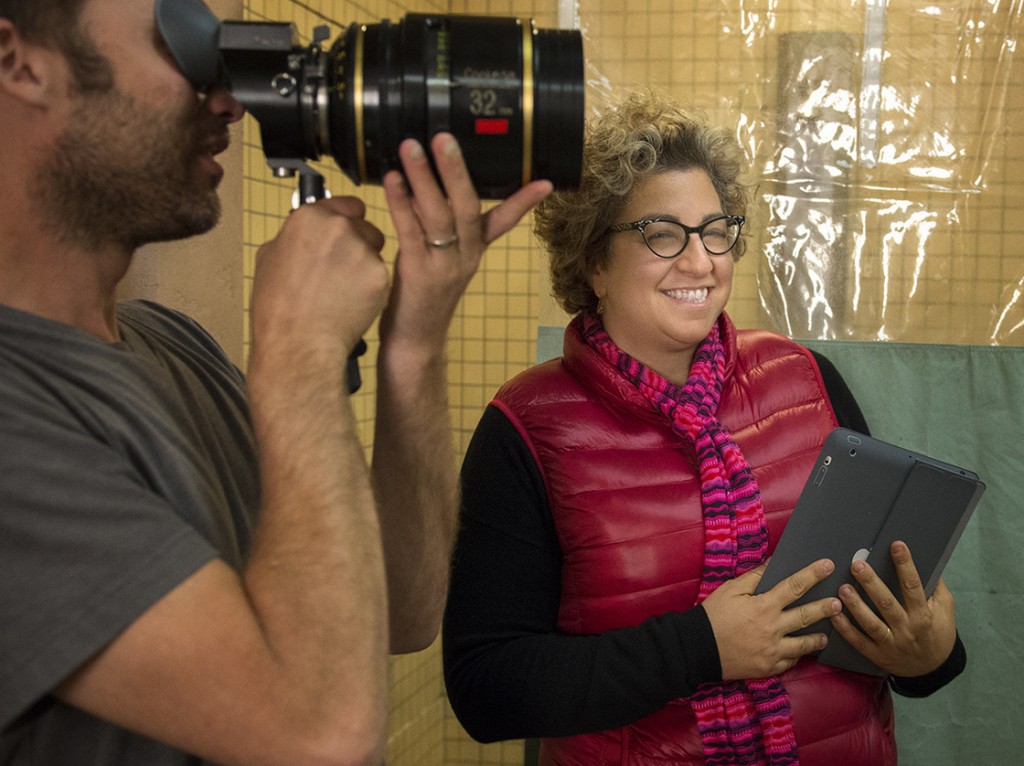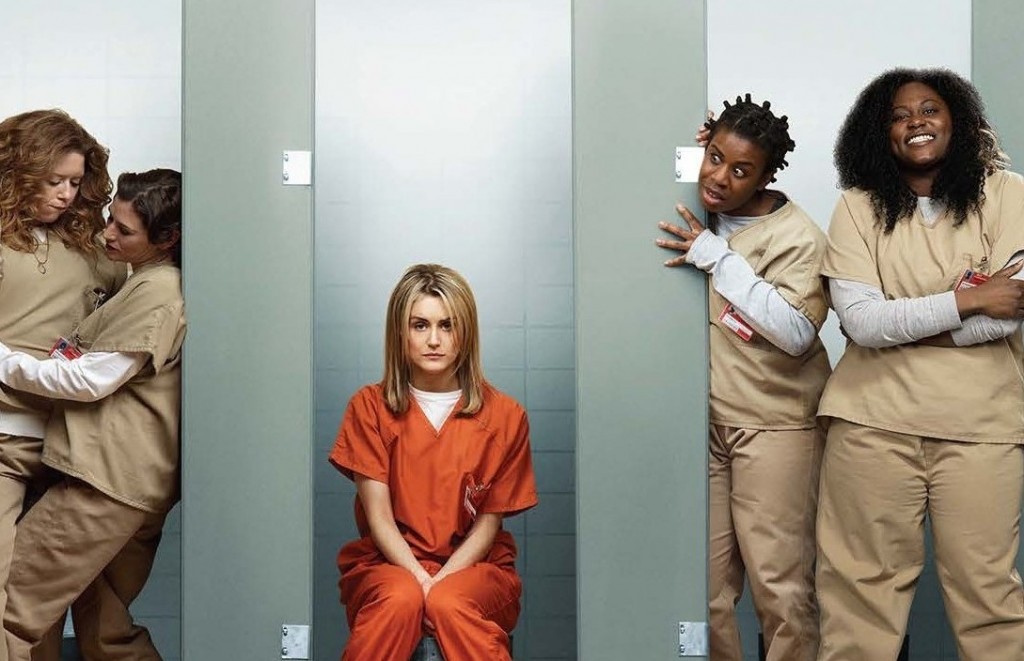IS ORANGE THE NEW BLACK
OR THE SAME OLD WHITE?
August 13, 2013
‘Orange’ Creator Jenji Kohan:
‘Piper Was My Trojan Horse‘
Listen to the story:

Janae Watson (Vicky Jeudy), Piper Chapman (Taylor Schilling) and Dayanara Diaz (Dascha Polanco) arrive in prison in the first episode of Orange Is the New Black. / Barbara Nitke/Netflix
A lot of people have been binge-watching the new Netflix series Orange Is the New Black, which is set in a minimum security women’s prison.
The show’s premise comes directly from a memoir of the same name: A white, middle-class woman named Piper, who graduated from a prestigious women’s college, became involved romantically with a woman who was working for a drug ring. They traveled together on out-of-town business, and Piper agreed to carry a suitcase of drug money. She wasn’t caught, but years later she was named in a drug conspiracy, convicted and sent to prison.
Beyond that basic premise, Orange‘s writers have created a fictionalized version of Piper’s story, as well as fictional backstories for the inmates Piper is serving time with.
The memoir was adapted for Netflix by Jenji Kohan, who is also the showrunner, overseeing production of the series. Kohan also created the Showtime seriesWeeds. She tells Fresh Air‘s Terry Gross about the show’s close-knit cast, why she chose Netflix, and what draws her to stories about privileged white women and criminality.

Jenji Kohan, seen here on the set ofOrange Is the New Black, began her writing career on The Fresh Prince of Bel-Air. / Ursula Coyote/Netflix
Interview Highlights
On what drew her to Orange when she read it
“I’m always looking for those places where you can slam really disparate people up against one another, and they have to deal with each other. There are very few crossroads anymore. We talk about this country as this big melting pot, but it’s a mosaic. There’s all these pieces, they’re next to each other, they’re not necessarily mixing. And I’m looking for those spaces where people actually do mix — and prison just happens to be a terrific one.”
On stories about privileged white women and criminality
“In a lot of ways Piper was my Trojan Horse. You’re not going to go into a network and sell a show on really fascinating tales of black women, and Latina women, and old women and criminals. But if you take this white girl, this sort of fish out of water, and you follow her in, you can then expand your world and tell all of those other stories. But it’s a hard sell to just go in and try to sell those stories initially. The girl next door, the cool blonde, is a very easy access point, and it’s relatable for a lot of audiences and a lot of networks looking for a certain demographic. It’s useful.”
On using flashbacks as narrative device
“When you’re writing a show, [it] is your life. And I did not want to spend all my days in prison. It seemed really oppressive, and potentially depressing, and I wanted to build in a structure where I could get out, and these people could get out, and we could have some blue skies and wear some actual clothes, as opposed to uniforms. The bonus of that was that you get to see a fuller picture of who these people are. Because everyone wears a mask, to a certain extent, in prison; you take on a persona to survive, and there’s more to these people than what they’re displaying in this extreme situation.”
On her close-knit cast
“The wealth of talent in this pool has been remarkable. The women that Jen Euston, our casting director, has brought in are so talented, and the bench goes so deep. Like Crazy Eyes, who is one of the real breakout characters on the show — I think [actress Uzo Aduba was] No. 50 on the call sheet, and she’s a star. They’re all stars. And they’re dazzling, and they’re enthusiastic, and they adore one another. And when their scenes are done, they stick around and watch other people do their scenes, and they hang out on the weekends. It’s kind of been a love-fest on the set.”
More On ‘Orange Is The New Black’
On why she chose Netflix as a distribution channel
“I took it to HBO and Showtime and Netflix. And the greatest thing about going to Netflix was that I pitched it in the room, and they ordered 13 episodes without a pilot. That’s miraculous. That is every showrunner’s dream, to just ‘go to series’ and have that faith put in your work. They paid full freight. They were new, they were streamlined, they were lovely, they were enthusiastic about it. And I love being on the new frontier. I love being first out of the gate. It’s really, really fun, because I think it is the future in a lot of ways, of how people consume media, and it’s great to be in there early.”
On how she started writing
“My ex-boyfriend said, ‘You have a better chance of getting elected to Congress than getting on the staff of a television show.’ Which was the perfect thing for him to say, because my entire career is, ‘Well, screw you.’ And we broke up. And then I started writing. … I quit all of my crappy odd jobs, and I moved in with [a friend who] was living in Santa Cruz. And every day we would go to these little cafes in Santa Cruz, and I would work on spec scripts and study these videotapes I had recorded off television of Roseanne and Seinfeld and The Simpsons. … What ended up happening was, my sister-in-law’s father worked in a building with an agent and gave him my scripts in an elevator. And he read them, and I was on a show by spring. And it took off from there, and I never stopped working.”
On Orange‘s Ira Glass-like character
“I’m a huge Ira Glass fan; I’m a huge fan of radio in general. I don’t have a whole lot of time to watch TV, but I’m a big podcast listener, a big radio listener and a fangirl to a certain extent. … [But] in terms of storytelling, we wanted a way for all of the prisoners to be able to experience [Piper’s fiance’s] betrayal. He’s sort of co-opting her experience to make himself feel useful and special, and radio was a great way to do that. … I find This American Life so compelling, and I engage on a very deep level with these stories, so I wanted that in our show — where everyone is quiet and listening.”
__________________________
August 16, 2013

Courtesy of Orange Is the New Black.
Slave narratives became most fashionable among abolitionist circles in the mid-nineteenth century. These narratives remain deeply powerful, yet each one is framed by a white introduction, which authenticates the black experience. The white practice of verifying the lives of black fugitives who were skillfully plotting their own liberation has changed in circumstance and in medium—but the role of white people at its center has not. Today, its latest manifestation is playing out in the Netflix hit series, Orange Is the New Black.
I first saw a poster for the new series on a subway platform. The word “black” plastered near women of all colors in prison jumpsuits made me shake my head in disappointment, but I soon forgot about it along with all the other racist images I’m surrounded by daily. The next time I saw a reference to Orange Is the New Black was on a giant video billboard during the massive march in New York following George Zimmerman’s acquittal in connection with the killing of Trayvon Martin. As thousands of people took to the streets against white supremacy, there was an intense irony about a fictionalized depiction of black women cheering on a prison fight as a very blond white woman stood there, shocked with horror. I crudely tweeted, “Racist shit playing W 35 and 6th. It never ends. Neither do we. #HoodiesUp,” with a looping vine to illustrate my disappointment.
Since that time, many a friend and colleague has taken the time to explain to me that I was wrong about my gut reaction to Orange Is the New Black. They point out that the series is based on a book, whose author, Piper Kerman, spent time in prison. I answer that Assata Shakur wrote a brilliant book titled Assata: An Autobiography that includes details about her time as the only woman in an all-men’s prison—yet I’ve not seen it developed into a series. It would be timely to do so now that Shakur is the first woman on the FBI’s Most Wanted Terrorist list.
Orange Is the New Black defenders repeatedly tell me that Kerman is invested in prison reform. She very well might be. But the problem here lies in the fact that her investment in the issue has been repaid through a very different kind of investment in her by book publishers and budding media empires like Netflix. I don’t necessarily doubt that Kerman wants to see a change in the criminal justice system—just like I don’t doubt that she’s made a cottage industry for herself doing so. This started about a decade ago, when Kerman began selling “Free Piper” T-shirts through Paypal. As a bestselling author who’s sold the rights to stories of women that aren’t even hers, she’s profited from the criminalization of black and brown women who are disproportionately targeted for prison cages.
But most often, Orange Is the New Black fans tell me I need to give the series a real chance. If I can just get through the first two episodes, I’ll be content by episode three. And so I watched and cringed through six whole episodes, called it quits and hope to never again see another one in my entire life. With very little exception, I saw wildly racist tropes: black women who, aside from fanaticizing about fried chicken, are called monkeys and Crazy Eyes; a Boricua mother who connives with her daughter for the sexual attentions of a white prison guard; an Asian woman who never speaks; and a crazy Latina woman who tucks away in a bathroom stall to photograph her vagina (the pornographic image is indiscriminately paraded throughout an entire episode).
This, it turns out, is what some of my friends and colleagues are gorging themselves on. I reject that it’s a guilty pleasure. If we’re addicted to Orange Is the New Black, then we’re strung out on the drug of spectacle—jonesing for hateful, racist images created by a white imagination for profit and fame. What most bothers me about this is that so many people have told me they hated the advertising posters and the ridiculous Facebook photos, and they always repeat that they wanted to turn Orange Is the New Black off during the first couple of episodes but kept watching—going against inclination, and buying into the garbage that keeps our eyes glued to something we know we shouldn’t be enjoying to begin with.
I will acknowledge that Orange Is the New Black has created a credible role for a trans black woman, played by Laverne Cox, an actual trans black woman. And I can’t deny that the series has created a payroll for many actors of color. But again, just like the practice 150 years ago during the height of the slave narrative era, those experiences are first authenticated by a white person—in this case, a white woman whose prison stint can never be a substitute for the violence institutionally carried out against women of color in the criminal justice system. It’s 2013, not 1861, and we don’t need Piper Kerman or anyone like her to substantiate what we already know.






